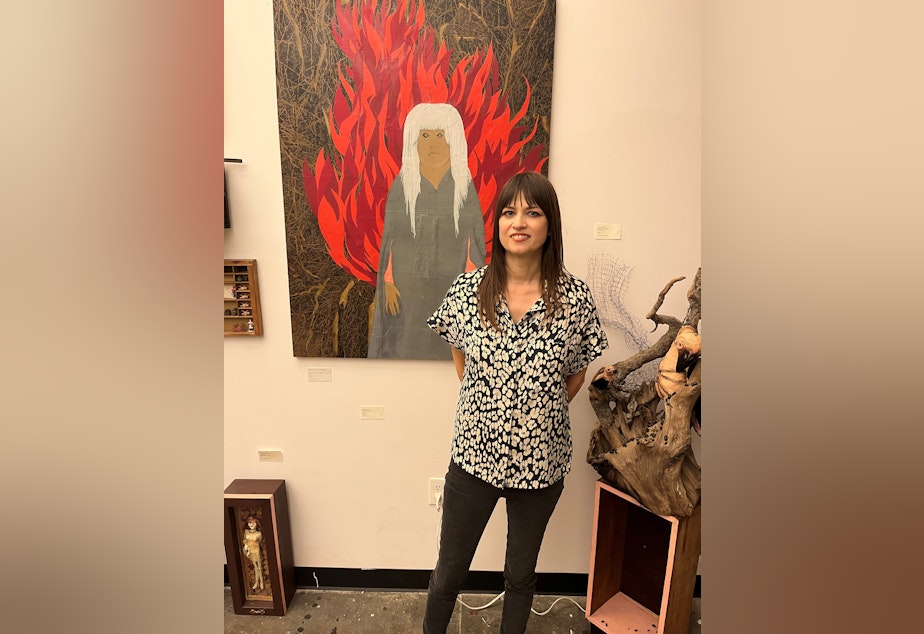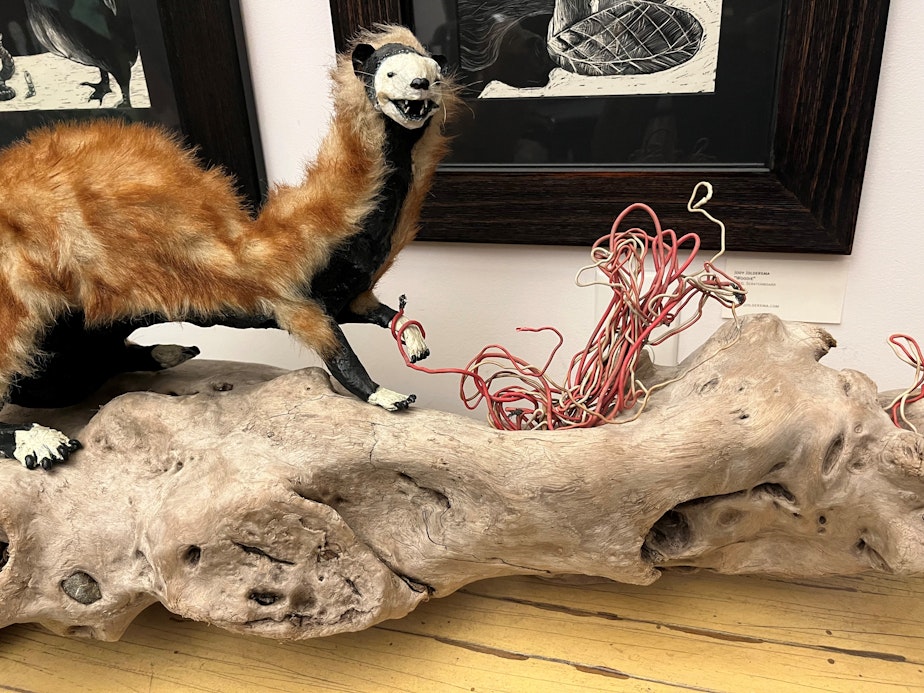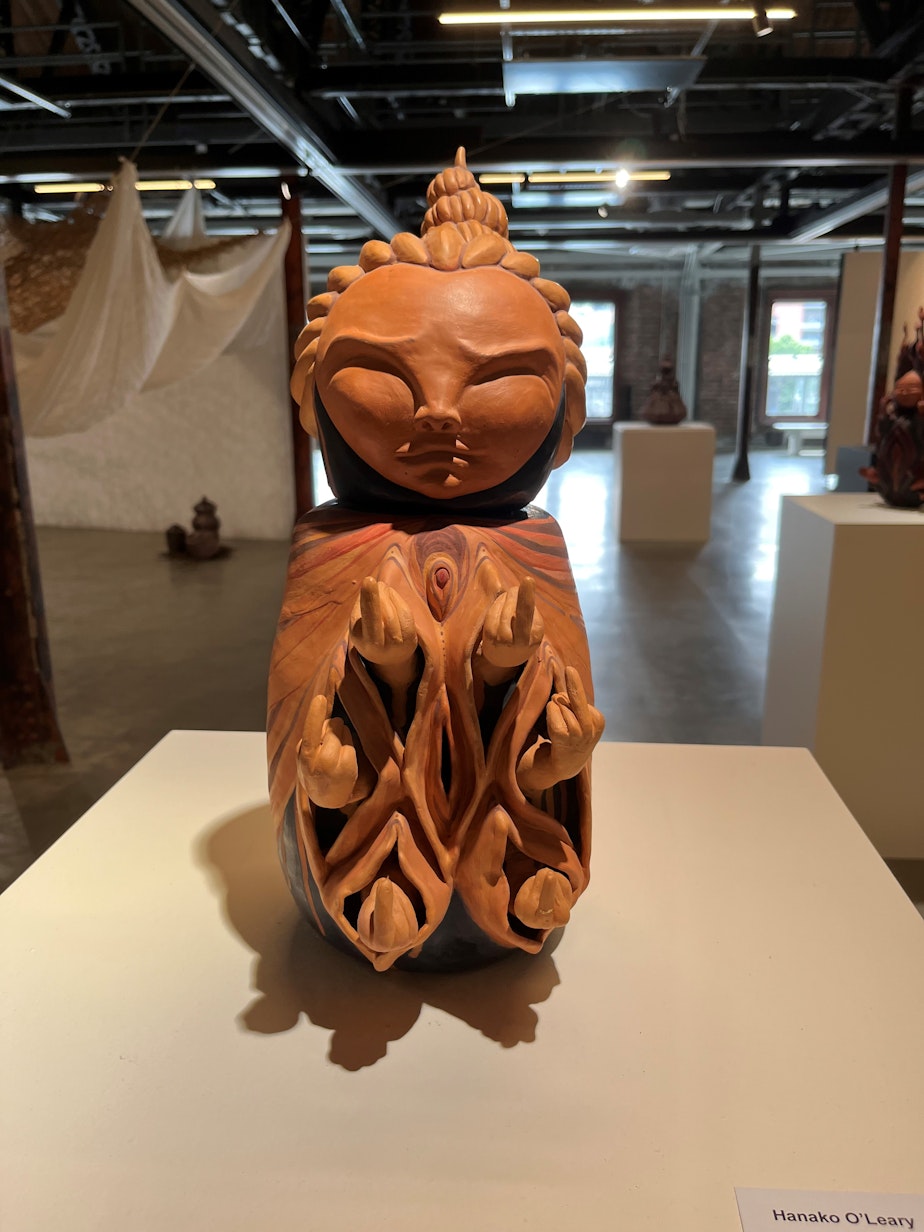Trapped weasels and middle fingers. Seattle artists react to Roe

People in Seattle are still coming to grips with the Supreme Court’s landmark overturning of Roe V Wade.
Artists in our communities are no different.
Some have responded by creating public works that display their inner emotions in the hopes it will lead to impactful discussions on these complex issues.
Jody Joldersma is a visual artist who's been incorporating reproductive rights and the idea of bodily autonomy into her work for years. She said the Supreme Court ruling didn’t surprise her at all. She feels the polarization of our culture has led to a societal divide that made this time period ripe for the overturning of Roe.
But the art she’s been creating lately is full of surprises.
Joldersma’s art studio is in a building she shares with dozens of other artists on the edge of the International District. All of the surfaces in her tight space are covered with her paintings and sculptures. One sculpture features a furry animal whose foot is caught in electrical wire.
“This is supposed to be a female weasel kind of thing,” Joldersma explained. “And it's trapped in a man-made wire. And this symbolizes our society, or forces outside of women, patriarchy, or that kind of thing. So, now she's gotta make the choice. Is she going to chew her foot off to get out? Or is she just gonna wait there to get predatorized?”
Sponsored

Even before the recent Supreme Court ruling, Joldersma didn’t believe the government was doing enough to protect women.
“Maybe the answer is finally getting the Equal Rights Amendment for women,” she said. “So that we're fully protected in the Constitution in an undeniable way. I really don't know. I'm just trying to make art to discuss it.”
Like Joldersma, artist Hanako O’Leary also creates art symbolizing reproductive rights.
A recent showing of O'Leary's work at King Street Station included a ceramic vessel she made in 2018.
Sponsored
“When Trump first got elected, I think during his inauguration, there was this woman, this Asian Auntie in a purple parka, who just stood there the whole time with her two middle fingers extended,” O’Leary said. “And it became a meme. Everyone called her ‘resistance auntie.’ And that image was just like, burned into my head. And I just really loved her. So, when I made this first jar, originally, I was just feeling really angry. And I needed a place to hold the anger. So, it was my anger jar. And I modeled it off her. She was my inspiration.”

This anger jar, like many of O’Leary’s ceramic pieces on display at King Street Station, depicts multiple hands with middle fingers extended.
“The fact that the most offensive gesture we can throw at somebody is to violate their physical being by basically entering it without their consent because we're mad at them, and so therefore, they deserve that," O'Leary said. "Everything about that felt really violent towards the people whose bodies we decide are designed to accept that gesture.”

Sponsored
O’Leary’s art is influenced by her personal experience.
In 2018, when she started the collection that was on display at King Street Station, she had just had an abortion herself.
“It was just like an impulsive reaction,” she said. “It was like an emotional response to everything that I was going through at the time. So yeah, this whole series started after I had an abortion, and I kind of just felt like, really upset… I was just thinking about how [for] many people it's just like, so hard to get, or just not even an option at all to be considered.”
Since then, O’Leary has continued to create pieces in this collection, which she calls "Izanami," in reference to the Japanese folktale of the Shinto goddess of life and death.
Like Joldersma, O'Leary said she wasn't suprised by the Supreme Court decision overturning Roe. She said her work speaks to issues of reproductive rights and will continue to do so.
Sponsored
“I think the work that I make has always reflected the anticipation of this moment,” O’Leary said. “And just the knowing that the truth that has always existed, that this moment is a reflection. And yes, I'm sure whatever I make is going to be a continuation of speaking to these issues, these inequities, these struggles in power that exist within our society.”
Many artists, like Joldersma and O’Leary, are still processing and working through ideas solidified by the Supreme Court ruling.
In the coming years, expect to see a wave of new art that not only reflects this current moment, but all the moments that have led us here.




